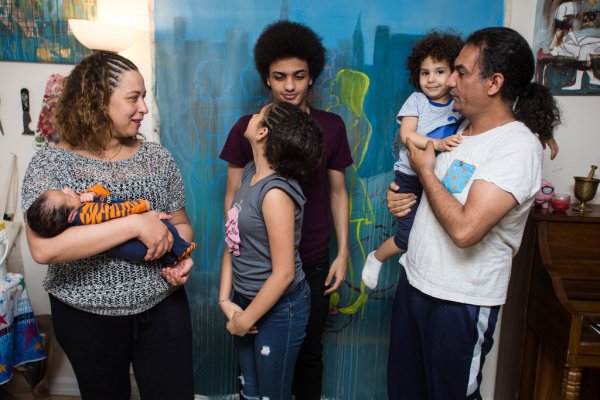Reda Abdelrahman, 43, is an artist who lived through the Egyptian revolution and now uses different media to express his political views. In 2013, he moved to Queens to escape government persecution.
Mr. Abdelrahman, who once was a professor at the Art institute in Cairo but left teaching to focus on his art, described his work as contemporary. “I like to get my inspiration from ancient Egyptian art but tackle modern issues,” he said.
He had many interests before the revolution, but politics was not one of them. That was until Jan. 25, 2011, came, and the revolution began.
Mr. Abdelrahman brought a 12-foot-by-4-foot canvas to Tahrir Square, the heart of the revolution, to draw the crowd. He asked people to sign their names on the canvas.

“I want everyone to participate in my piece of art,” he said on May 26 in an interview conducted in Arabic. “For the first time, I saw Egyptians working together and coming together toward one goal: getting rid of Mubarak,” Mr. Abdelrahman said, in a reference to Hosni Mubarak, Egypt’s president from 1981 to 2011.
After the revolution, Mr. Abdelrahman said he was driven to explore why people were divided in Egypt and around the world by religions and cultures. “I wanted to show that we are all the same, no matter what kind of religion you believe in or who you worship,” he said.
In June 2012, a member of the Muslim Brotherhood, Mohamed Morsi, was elected president by the people. The election was the first popular vote in modern Egyptian history. And even though over 90 percent of Egyptians are Muslim, the country had long been secular. After the Muslim Brotherhood won, it attempted to model Egypt after Saudi Arabia, which has strict Shariah law. This was something that Egyptians like Mr. Abdelrahman did not see coming. Mr. Morsi was removed as president on June 30, 2013, and the country, now led by President Abdel Fattah el-Sisi, remains under military rule.
Mr. Abdelrahman’s political artwork was shown in many exhibits around Cairo in late 2012 and 2013, while the power structure in Egypt was still in transition. In one recent series, Mr. Abdelrahman incorporated donkeys into his painting as symbols of the mistreated citizens of Egypt.
One of his sculptures attracted unwanted attention from the Muslim Brotherhood administration and Mr. Morsi’s supporters while on display in a church in Cairo. On this particular donkey sculpture, Mr. Abdelrahman painted the face of Mr. Morsi and a military uniform.
Clockwise from left: One of Reda Abdelrahman’s paintings in his apartment in Woodhaven, Queens. Top right: Mr. Abdelrahman works on a donkey sculpture that will be displayed in a London exhibition. Above right: Mr. Abdelrahman’s artwork is inspired by Egypt and Egyptian politics. Khaled Sayed / NYT Institute
“I was trying to say with this sculpture that Morsi is the head of the state, but the Egyptian military is still in control of everything in Egypt,” he said. The sculpture was eventually moved to St. Paul’s Cathedral in London.
“The donkey is a misunderstood animal in Egypt,” Mr. Abdelrahman said. “People depend on donkeys in all neighborhoods in Egypt. Donkeys are attached to carts overloaded with goods, fruits and vegetables to transport them to customers,” he said. “However, donkeys are underappreciated and always accused of being stupid. They are often beaten with wire and wooden sticks.” Not only do donkeys suffer abuse on a daily basis, but the term “donkey” is a slur.
In an exhibit expanding on the donkey theme, Mr. Abdelrahman created paintings and sculptures.
“If you call someone a donkey, you are saying that this person is stupid and worthless,” Mr. Abdelrahman said. “It’s a huge insult, so what I tried to do with ‘The Donkey’ exhibit is to celebrate the donkey’s kindness and its ability to face abuse and mistreatment,” he said. “I used the donkey image to insult Egyptian men, even President Morsi, by representing men as donkeys because that way they could understand the insult.”

Mr. Abdelrahman faced many threats over his art and views from the Islamist groups running the country after the revolution. “I had to leave Egypt. My life was in danger and my family was not safe there,” he said.
Mr. Abdelrahman has been working in New York, and his latest collective exhibition in this year was called “The Bridge.” For more information about him, go to his website: http://www.redaabdelrahman.com.
Correction: An earlier version of this article incorrectly stated the date that Mohamed Morsi was removed as president of Egypt. It was July 3, 2013, not June 30.






